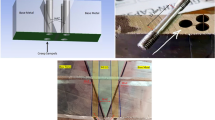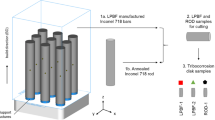Abstract
In this work, resistance spot welding of AISI 201 stainless steel is investigated experimentally and numerically. In the experimental work, based on design of experiments with Box–Behnken design and response surface methodology, effects of process parameters such as welding current, welding time, electrode force and cooling time on tensile-shear strength and failure mode of resistance spot welds are investigated. The results show that tensile-shear strength of spot welds is increased with increasing the welding current and welding time due to increase in the generated heat and consequently plastic deformation area. Also, it is concluded from results that tensile-shear strength is increased with increasing the electrode force. However, with increasing the electrode force, electrode indentation in the sheets is increased, and when the electrode force is excessively raised, the cross section of weld metal and consequently the strength of welded joints are decreased. It is obtained from results that tensile-shear strength of spot welded joints is increased with increasing the cooling time. However, when the cooling time is increased excessively, the welded joints strength is decreased. During tensile-shear test, two failure modes were observed, namely pullout and pullout with tearing of the sheet modes. In the numerical simulations, using an electro-thermo-mechanical analysis, the effect of welding current on fusion zone size is investigated and compared with experimental measurements. The results show that numerical simulations are in good agreement with experimental works. Also, it is concluded that the nugget diameter is increased with increasing the welding current.
Similar content being viewed by others
References
Wan X, Wang Y, Zhang P (2014) Modelling the effect of welding current on resistance spot welding of DP600 steel. J Mater Process Technol 214(11):2723–2729
Zhang H, Qiu X, Bai Y, Xing F, Yu H, Shi Y (2014) Resistance spot welding macro characteristics of the dissimilar thickness dual phase steels. Mater Des 63:151–158
Kianersi D, Mostafaei A, Amadeh AA (2014) Resistance spot welding joints of AISI 316L austenitic stainless steel sheets: phase transformations, mechanical properties and microstructure characterizations. Mater Des 61:251–263
Charde N, Yusof F, Rajkumar R (2014) Material characterizations of mild steels, stainless steels, and both steel mixed joints under resistance spot welding (2-mm sheets). Int J Adv Manuf Technol 75(1):373–384
Thakur AG, Nandedkar VM (2014) Optimization of the resistance spot welding process of galvanized steel sheet using the Taguchi method. Arab J Sci Eng 39(2):1171–1176
Wang J, Wang HP, Lu F, Carlson BE, Singler DR (2015) Analysis of Al-steel resistance spot welding process by developing a fully coupled multi-physics simulation model. Int J Heat Mass Transf 89:1061–1072
Spitz M, Fleischanderl M, Sierlinger R, Reischauer M, Perndorfer F, Fafilek G (2015) Surface lubrication influence on electrode degradation during resistance spot welding of hot dip galvanized steel sheets. Int J Mater Prod Technol 216:339–347
Zhang W, Sun D, Han L, Li Y (2015) Optimised design of electrode morphology for novel dissimilar resistance spot welding of aluminium alloy and galvanised high strength steel. Mater Des 85:461–470
Shawon MRA, Gulshan F, Kurny ASW (2015) Effect of welding current on the structure and properties of resistance spot welded dissimilar (austenitic stainless steel and low carbon steel) metal joints. J Inst Eng (India) Ser D 96(1):29–36
Minko Z, Bartnik Z (2016) Heating of electrodes during spot resistance welding in FEM calculations. Arch Civ Mech Eng 16(1):86–100
O. L. Ighodaro, E. Biro, Y. N. Zhou. Comparative effects of Al-Si and galvannealed coatings on the properties of resistance spot welded hot stamping steel joints. J Mater Process Technol. Available online 24 March 2016, doi: 10.1016/j.jmatprotec.2016.03.021.
Wang B, Hua L, Wang X, Song Y, Liu Y (2016) Effects of electrode tip morphology on resistance spot welding quality of DP590 dual-phase steel. Int J Adv Manuf Technol 83(9):1917–1926
Kim D, Yu J, Rhee S (2016) Effect of a conically shaped hollow electrode on advanced high strength steel in three-sheet resistance spot welding. Int J Precis Eng Manuf 17(3):331–336
X Luo, J Ren, D Li, Y Qin, P Xu. Macro characteristics of dissimilar high strength steel resistance spot welding joint. Int J Adv Manuf Technol. 1–9. doi: 10.1007/s00170-016-8581-9. First online: 09 March 2016
Society AW (1997) Recommended practices for test methods for evaluating the resistance spot welding behavior of automotive sheet steel materials. AWS, Miami, ANSI/ AWS/SAE/D89-97
Author information
Authors and Affiliations
Corresponding author
Ethics declarations
This paper is our original work and has not been published or submitted elsewhere. This paper was not funded by anywhere. Also, the authors declare that they have no conflict of interest.
Rights and permissions
About this article
Cite this article
Safari, M., Mostaan, H., Yadegari Kh., H. et al. Effects of process parameters on tensile-shear strength and failure mode of resistance spot welds of AISI 201 stainless steel. Int J Adv Manuf Technol 89, 1853–1863 (2017). https://doi.org/10.1007/s00170-016-9222-z
Received:
Accepted:
Published:
Issue Date:
DOI: https://doi.org/10.1007/s00170-016-9222-z




